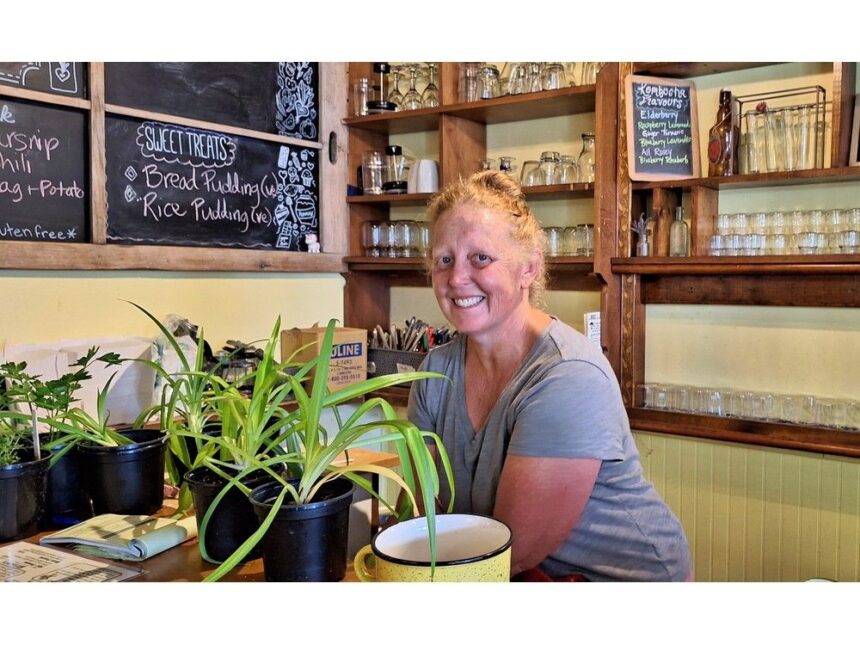Determined not to let a scrap of food go to waste, these Maritimers are turning to old preservation techniques like canning, fermentingPublished Jul 18, 2025Last updated 1 hour ago8 minute readAmy Smith behind the counter at The Farmacy and Fermentary in Charlottetown. She and her partner, Verena Vargas, preserve Island produce using traditional fermentation methods. Judith MendioleaArticle contentAmy Smith stood in her P.E.I. kitchen, staring down at a table overflowing with cucumbers.THIS CONTENT IS RESERVED FOR SUBSCRIBERS ONLY.Subscribe now to access this story and more:Unlimited access to the website and appExclusive access to premium content, newsletters and podcastsFull access to the e-Edition app, an electronic replica of the print edition that you can share, download and comment onEnjoy insights and behind-the-scenes analysis from our award-winning journalistsSupport local journalists and the next generation of journalistsSUBSCRIBE TO UNLOCK MORE ARTICLES.Subscribe or sign in to your account to continue your reading experience.Unlimited access to the website and appExclusive access to premium content, newsletters and podcastsFull access to the e-Edition app, an electronic replica of the print edition that you can share, download and comment onEnjoy insights and behind-the-scenes analysis from our award-winning journalistsSupport local journalists and the next generation of journalistsRegister to unlock more articles.Create an account or sign in to continue your reading experience.Access additional stories every monthShare your thoughts and join the conversation in our commenting communityGet email updates from your favourite authorsSign In or Create an AccountorArticle contentIt was mid-August 2013, the peak of harvest, and she and her partner, Verena Vargas, had more produce than they could sell, gift or give away.Article contentArticle content“There was no way we were going to stand over a pot of boiling water making pickles the traditional way,” Smith said.Article content“It was just too hot. We were tired. We needed a shortcut.”Article contentArticle contentThat shortcut — a simple saltwater brine — would quietly change the direction of their farm business and introduce them to the world of fermentation.Article content“My partner found a recipe for fermented pickles. You just had to submerge them in brine and wait,” Smith said. “The flavour blew us away.”Article contentA business is bornArticle contentSmith and Vargas now run The Farmacy and Fermentary in Charlottetown, P.E.I., a small-batch fermentation shop using organic produce from their own farm. Their fermented creations — from Thai-inspired sauerkraut to kimchi powder — are part of a growing movement to preserve seasonal abundance in creative, sustainable ways.Article contentAnd they’re not alone.Article contentThere’s been a sharp uptick in online searches for terms like “fermentation,” “water-bath canning” and “how to preserve garden vegetables” in the years since pandemic lockdowns — a trend that has remained steady well into 2025.Article contentArticle contentInterest in preserving food is no longer niche; it’s part of a broader shift toward sustainability, affordability and food security.Article content Amy Smith, in front of The Farmacy and Fermentary, located in downtown Charlottetown. The shop specializes in small-batch fermentation using produce from the couple’s own farm. Judith MendioleaArticle contentArticle contentFermentation: Safe, simple and aliveArticle contentWhile canning and freezing are still popular, Smith said fermentation is “hands down” the safest and most accessible preservation method — and one that requires no special equipment.Article content“As soon as you add the proper amount of salt, you create an acidic environment where only good bacteria can thrive,” she said. “It’s microbiologically stable — and delicious.”Article contentA 2023 report from the University of California, Davis, confirmed that fermentation not only prevents spoilage but enhances nutritional content by increasing B vitamins, promoting probiotic growth and improving digestibility.Article contentAt The Farmacy, the basic formula is simple: two per cent salt to the weight of the vegetables.Article content“Use a two per cent brine — that’s two per cent salt to the weight of your vegetables,” Smith explained. “And always use the right salt. Kosher salt is great for canning, but terrible for fermenting. It has anti-caking agents that inhibit the process.”Article contentWater matters, too.Article content“If you’re on city water, let it sit out 24 hours to off-gas the fluoride and chlorine,” she said.Article contentThe vegetables should be as fresh as possible.Article content“The fresher the produce, the better the ferment. Grocery store produce can be too old or irradiated,” she added.Article content Amy Smith slices fresh radishes at The Farmacy. “The fresher the produce, the better the ferment,” she said. Judith MendioleaArticle contentCustomized to tastesArticle contentFerments can be tailored to individualized tastes when you’re doing it yourself.Article content“Some people love a crunchy, young ferment after a week or two. Others want something more aged and complex. You get to customize it,” explained Smith.Article contentDifferent vegetables require different approaches. Cabbage, for example, creates its own brine. Carrots, beets and cucumbers need added brine. And softer vegetables, when over-fermented, can be dehydrated and ground into powders — a trick The Farmacy uses to salvage batches they’re not fully satisfied with.Article contentArticle content“We had a kimchi that went a little too far. It was too soft,” Smith said. “So we dehydrated it and made kimchi powder. It’s still alive, full of good bacteria, and tastes amazing.”Article contentAmong their house favourites are ginger beer brewed with a ginger bug — “which is just fermented ginger and sugar,” Smith said — and kombucha-flavoured with frozen Island berries.Article content Bottled kombucha chills in a fridge at The Farmacy. Flavours rotate seasonally and often include frozen Island berries. Judith MendioleaArticle contentKeeping it cool: preserving fruit and vegetablesArticle contentWhile fermentation lets produce evolve and transform, freezing offers an immediate way to preserve it in its freshest state.Article content“We buy as much local fruit as we can in the summer and freeze it. Verena uses it to flavour kombucha all year,” Smith said.Article contentAccording to Agriculture and Agri-Food Canada, freezing fruits and vegetables shortly after harvest preserves between 85 and 95 per cent of their original nutrient content. When stored properly at –18°C, most frozen produce can last six months or longer without significant loss of flavour or texture.Article contentArticle contentFreezing is ideal for berries, beans, corn, tomatoes and even herbs. And unlike canning, it doesn’t require sterilization or pH monitoring.Article content“Just blanch, chill and bag it airtight,” Smith said. “You’ll thank yourself in February.”Article content Non-fermented pickles line in the fridge at The Farmacy and Fermentary in Charlottetown, P.E.I. Judith MendioleaArticle contentCanning traditionsArticle contentWhile freezing is fast, canning offers the comfort of an old recipe card and a steaming kitchen — a preservation tradition passed down through generations.Article contentOn the other side of the Maritimes, Dorcas Pleasant manages the urban farm at Hope Blooms, a youth-led social enterprise in Halifax’s North End. The community garden feeds over 150 families in nearby housing units — and every cherry tomato, radish and cucumber is harvested by local children and teens.Article content“We produce eight salad dressings, mushroom coffee, tea, hot chocolate — all right here at Hope Blooms,” Pleasant said. “That’s part of our youth-led social enterprise.”Article contentFor someone trying to avoid food waste but lacking the time for creative preservation methods, donations are always a good way to contribute to the community.Article content“The kids pick the food and take it home,” Pleasant said. “We don’t waste anything. If there’s ever a surplus, we let people walking by know — or we post it online. It’s gone by the end of the day.”Article contentMost of the produce is distributed fresh, but Pleasant said preservation is woven into the fabric of the space.Article content“We’ve made dandelion honey — we pick all the heads and our chef turns them into something special. You only boil it, and we give that to guests as a thank-you,” she said.Article contentThey also make mustard pickles and occasionally can salsas and sauces during community events.Article contentAt The Farmacy, Smith and Vargas still put up tomatoes, jams and pepper jellies every summer.Article content“We smoke and roast our heirloom tomatoes with jalapeños and onions from the farm, then we can the salsa in a hot-water bath,” she said. “It’s labour-intensive, but worth it.”Article contentArticle content Herbal teas at The Farmacy blend dried flowers, roots and leaves — many grown and harvested on site. Judith MendioleaArticle contentDrying herbs and ferments for shelf lifeArticle contentWhen it comes to herbs, neither Smith nor Pleasant likes to waste a sprig.Article content“Sometimes we blend or dry herbs for later, but mostly we use them fresh,” Pleasant said. “We go out and pick what we need.”Article contentDrying is one of the oldest preservation techniques — and one of the most energy-efficient. When done properly at low temperatures, it retains flavour and, in some cases, beneficial bacteria.Article content“We also dehydrate a bunch of things,” Smith said. “And one thing that’s kind of fun is if we have a ferment we don’t love, we dry it and grind it into a powder.”Article contentDehydrated kimchi becomes a probiotic seasoning; dried lemon balm becomes a calming tea blend. For Island households with limited fridge or freezer space, drying is a quiet but powerful tool.Article contentAnd in a country where food waste is a growing concern, every bit counts. According to a 2023 report by Second Harvest, 60 per cent of food produced in Canada is lost or wasted each year — much of it at the consumer level.Article contentArticle content A refrigerator stocked with ciders and syrup at The Farmacy. Products range from traditional kraut to Thai-inspired blends. Judith MendioleaArticle contentGut health and heritageArticle contentAs Smith and Vargas began selling their fermented products at the farmers’ market, they noticed something unexpected: people wanted to talk.Article content“We had folks coming to our booth and telling us about their gut issues,” she said. “Crohn’s, IBS, colitis — people were in pain. Then they’d come back and say, ‘I’ve been eating your kraut, and I’m not in pain anymore.’ That was powerful.”Article contentThough the stories are anecdotal, Smith said there’s growing research linking fermented foods and gut microbiota to overall health — including mental well-being.Article contentA 2023 meta-review published in Nutrients, an open-access journal of human nutrition, found that daily consumption of fermented foods was associated with improved microbiota diversity and reduced gastrointestinal inflammation in adults with IBS and related conditions.Article contentAnother 2023 review in Frontiers in Cellular and Infection Microbiology outlined how the gut microbiota interacts with the brain via the HPA axis (stress response), immune pathways and neurotransmitter production. It highlighted that “several strains of probiotics can provide critical benefits for preventing and treating depression.”Article contentWhat does this mean?Article contentThe gut microbiota is the ecosystem of microorganisms (bacteria) living in your digestive tract. It plays a vital role in digestion, immune function and mental health. Fermented foods feed the good bacteria we need — especially after decades of sanitizing habits.Article content“People have been taught to fear bacteria, especially during COVID. But the truth is, we need the good bacteria,” Smith said.Article content Roasted tomato salsas canned at The Farmacy. Smith and Vargas make their batches with heirloom tomatoes, jalapeños and onions from their farm. Judith MendioleaArticle contentFor many customers, Smith added, fermentation also becomes a way to reconnect with family traditions.Article contentArticle content“One woman came to our workshop and said, ‘My grandmother made this in Ukraine, but I never learned how.’ It’s really moving to see people rediscover their roots.”Article contentPreservation is, at its core, about connection — to the land, to culture, to memory. At both The Farmacy and Hope Blooms, it’s also about community and confidence.Article content“Just try it,” Smith said. “Don’t be scared. You don’t need perfection — just good ingredients and a little curiosity.”Article contentQuick start guide to food preservationArticle content(Research-backed and workshop-tested)Article contentArticle contentFermenting: Use a two per cent non-iodized salt brine (20 g salt per litre of water). Keep vegetables submerged and monitor pH — under 4.6 is the safety target. Store in a clean jar at room temperature and burp daily.Article contentFreezing: Blanch vegetables in boiling water for 1–2 minutes, then plunge into an ice bath. Dry, pack into airtight containers and freeze immediately.Article contentCanning: Use tested recipes. Water-bath can high-acid foods (e.g., tomatoes, fruit). Low-acid foods (e.g., beans, meat) require pressure canning. Always sterilize jars and ensure seals are airtight.Article contentDrying: Slice produce thin and evenly. Dry at 52–60°C until crisp. Herbs can air-dry away from sunlight. Store dried goods in airtight containers in a cool, dry place.Article content(Sources: Health Canada; University of California, Davis; USDA National Center for Home Food Preservation)Article content
A taste of summer all year: How to preserve your harvest using traditional techniques











